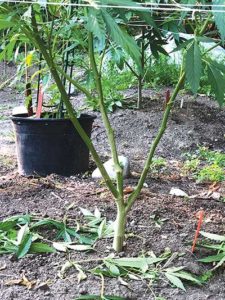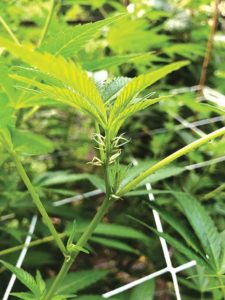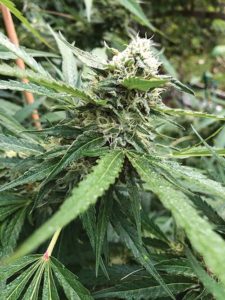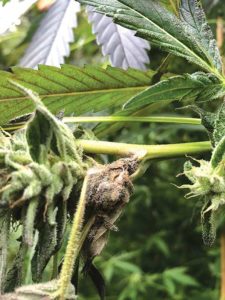 |
| Figure 1 – If you want lots of flowers, train your plant by cutting off lower branches that receive little sun (lollypopping). |
 |
| Figure 2 – Female flowers emerging |
 |
| Figure 3 – A plant that is ready to harvest. |
 |
| Figure 4 – Larger flowers retain water, creating conditions for botrytis (gray mold or bud rot) to set in. |
By John Jemison
Extension Specialist – Soil and Water Quality, University of Maine
Photos by the author
I have had the pleasure to work for Cooperative Extension for almost 30 years. I never dreamed when I started with Extension that I would ever be writing an article about how and why I think you should consider growing cannabis at home, but I think there are many good and interesting reasons why you should.
Cannabis has been a most maligned plant. The stigma associated with cannabis started in the 1930s and continues today in many communities. Consider reading about Harry Anslinger and his highly racist effort to demonize cannabis. Other, more thoughtful people think cannabis may have played a key role in enabling early humans to switch from a hunting and gathering culture to settle along rich river bottoms and initiate crop and livestock production. Regardless, cannabis should not be vilified; it has varied beneficial uses.
Much as cauliflower, broccoli and Brussels sprouts were all derived from one plant, Brassica oleracea, through plant breeding, Cannabis sativa has been bred to produce fiber, grain and medicines. Cannabis can be densely planted for fiber and grain, or planted with wider (5-by-5-foot) spacing for flower production, in which case a field of cannabis can resemble a Christmas tree operation.
Cannabis has both male and female plants. For fiber and grain production, you want the males to pollinate the female plants. Once that is accomplished, male plants have little use, and they wither and fade away. (One might extrapolate this to the utility of human males, but I’d rather not.)
The medicinal properties of cannabis are associated primarily with the female flower, particularly the trichomes, which are sticky resinous structures that under magnification look like little water towers. These are thought to protect the plant against insect feeding. Trichomes hold high concentrations of cannabinoid and terpene compounds. The cannabis plant has many cannabinoid compounds, the most famous of which is delta-9 tetrahydrocannabinol (THC), due its psychoactive effects. However, that is but one of many cannabinoids, most of which are not psychoactive and which provide health benefits. Plant breeders have bred both super-high-THC cultivars relative to what was used in the ‘60s and ‘70s, as well as lines very low in THC but high in other cannabinoid compounds, such as cannabidiol (CBD), cannabigerol (CBG) and cannabichromene (CBC). This has helped change how some people view and use cannabis.
Terpene compounds give the plant flower its characteristic aroma and affect the flavor profile of the specific cultivar. Botanically similar to the cannabis flower, flowers of hops plants are sticky, resinous and aromatic due to terpene compounds (pinene, limonene, etc.). These give specific hops varieties their characteristic aromas and give beers such as IPAs their specific flavor profiles. In some cannabis cultivars, terpenes provide flavor but may also intensify the effect of a specific cannabinoid. Had cannabis not been on the controlled substances list for the past 50 years with drugs such as heroin, peyote and LSD, we would have known far more about this plant!
Legislation passed in 2016 and amended in 2018 allows Maine adults to grow up to three flowering cannabis plants per adult in the household for personal use on their land. To grow more than that number, you need to follow state rules regarding licensing for hemp production or become a caregiver.
Why and Which Cannabis to Grow in the Garden
I grow cannabis plants because 15 years ago I had a significant grand mal seizure. I have had only one, but it wasn’t fun. I hope that regular consumption of high-CBD cannabis products might reduce my chances of another. The FDA evaluated and approved for children a high-dose CBD medication called Epidiolex, which is 99% pure CBD developed from greenhouse-grown cannabis, based on evidence that it helped control seizures. However, the FDA almost did not approve the medication due to concern about liver toxicity at high (20 mg/kg body weight) doses, but most of the CBD that I grow, make and use at home is closer to a 0.02 mg/kg daily dose.
People claim that CBD and other cannabinoids can help with conditions from arthritis and anxiety to improved skin, but as my raison d’être is to provide people with research-based information, I’ll just say we need more information. As more emerges, I’ll be happy to share. But we do know some things, thanks to work done outside the United States.
Israeli scientist Rafael Mechoulem showed that plant cannabinoids react in our body by affecting the endocannabinoid system. Receptors exist throughout the central nervous system that affect our mood, appetite and sense of well-being. Our bodies create endocannabinoid molecules such as anandamide, which is responsible for the feeling of well-being that one might experience following exercise. That short-lived chemical acts on the CB1 receptor. Phytocannabinoids, particularly THC, act on the same CB1 receptors to provide a similar feeling of well-being or euphoria.
Another set of receptors (CB2 receptors) works with CBD. Reportedly CBD slows the natural breakdown of anandamide, which is why CBD is said to improve homeostasis and provide a general feeling of well-being.
Finally, CBD can also block CB1 receptors, which is why the USDA rule that agriculturally-produced CBD hemp must contain less than 0.3% total THC on a dry weight basis is unnecessarily strict. Up to 1% THC has been shown to have no psychoactive effect, and with a high percentage of CBD in the flower, one could likely have over 1% THC and feel nothing because the CBD blocks the CB1 receptor sites. But that is why I grow and use high-CBD cannabis.
A National Academy of Sciences Engineering and Medicine meta-analysis of all research done on high-THC cannabis concluded that good evidence exists that high-THC cannabis can help relieve chronic pain, muscle spasms, nausea from chemotherapy, reduce ocular pressure from glaucoma, and reduce spasticity associated with multiple sclerosis. Select your cultivars based on your needs, but greenhouses should be selling high-CBD seedlings for summer planting.
When and How to Grow Cannabis
The cannabis plant might have mystical properties and provide useful benefits, but it is just a plant and is subject to all the same issues as all other cultivated plants. Growing cannabis involves basic agronomic considerations such as planting timing, water needs, spacing, fertility, as well as disease, insect and weed management.
Once you have sourced your plants and have adequately hardened them off, assess their health closely before planting. Like me, cannabis likes neither wet feet nor to be cold. I grow my plants in extremely fertile raised beds. My garden soil has 9 to 10% organic matter and a pH of 6.9. I apply a layer of aged manure or compost about one-half to 1 inch thick on top of the bed, work it in, and plant no earlier than June 1. If you don’t want to deal with large plants, consider planting around the summer solstice.
Overwatering can lead to diseases such as Pythium. Cannabis is adapted to lower water use than many plants, but don’t let your plants become overly stressed, as stress can make a female plant produce male flowers … bad news!
You can feed your plants with fish emulsion every three weeks.
If you want lots of flowers, train your plant by cutting off lower branches that receive little sun (lollypopping – see Figure 1) and trimming the top couple of inches off the leader of the plant to promote side shoots. Do this two or three weeks after transplanting with clean sharp shears. Don’t be afraid to cut lower branches up to a quarter of the way up the plant well before flowering. This will improve aeration, which is critical for disease prevention.
Cannabis is easy to grow (it is called weed), but like potatoes, it is hard to grow well. Walk your garden as often as possible, enjoy the aromas and the quiet, but carefully scout for anything that looks out of the ordinary – disease, insect damage, possible nutrient deficiency – and cultivate any weeds around your plants.
In early August start looking for the female flowers (those with stigmas) to begin to form (Figure 2). Make sure your female plant hasn’t turned into a hermaphrodite (a plant with both male and female flowers on it). By mid-September plants are in the late flowering/preharvest stage. They will be as large as they will be, and the flowers will be covered with trichomes. Watch for their color to start to change from clear to slightly opaque (Figure 3). Also be aware that as the days shorten and temperatures fall and humidity rises, disease pressure becomes your biggest nightmare. If possible after rains, gently shake as much excess water as possible from your plants. Larger flowers retain water, creating conditions for botrytis (gray mold or bud rot) to set in (Figure 4).
My best advice is to start your harvest in waves. By the third week of September, begin to watch the weather forecast. If days of rain are forecast, start harvesting the largest flowers first or totally harvest your plant. A few more days of growth is not worth using your cannabis as fire starter in the winter.
I hang plant branches from clotheslines in my basement at about 55% humidity and about 60 degrees F for about seven to 10 days.
This is a good time to purchase some two-way 62% humidity control packets. Once you are ready to store your flower for long-term use, the packets will protect your flower from drying out. If your flower is too moist, the packets will pull some of the moisture out.
At six days, begin to examine the branches and the flowers. If the branches snap, begin to cut and trim the flowers. The outside of the flower should be dry to the touch, but the inside should still be somewhat moist. Have comfortable shears and a tray on which to trim. Cut the leaves off the flowers and place the trimmed flower bud into quart or half-gallon bell jars. Don’t pack the flowers in the jar, as they need to lose water slowly from the inside to the outside of the bud while in the jar. This curing process is important to stop enzymatic flower degradation.
Store the jars in a cool, dark area. Open them for a couple of minutes to allow gas exchange at least a couple of times a day for the first week. If you smell ammonia in the jar, the plants were not sufficiently dry and should dry longer. After the first couple of weeks, continue to open the jars daily again for a couple of minutes to allow fresh air to enter the jar and moisture to escape. If you have managed to get to this phase, you have successfully grown, harvested and cured your first cannabis plants.
This article is for informational purposes only. Please consult a health care practitioner about serious medical issues. Any product endorsement is unintended.
